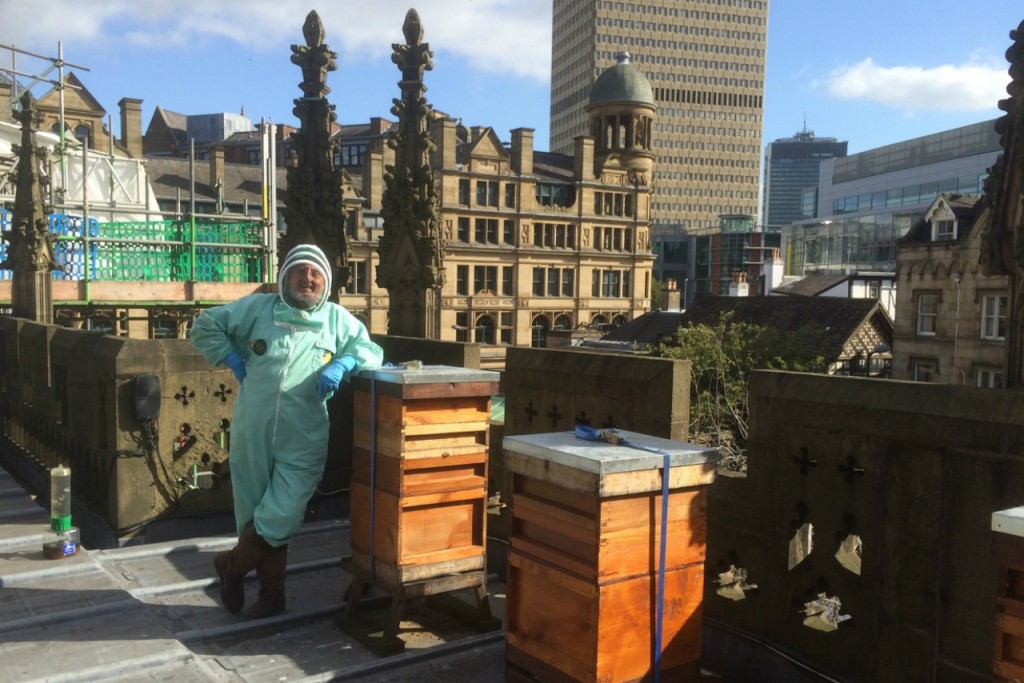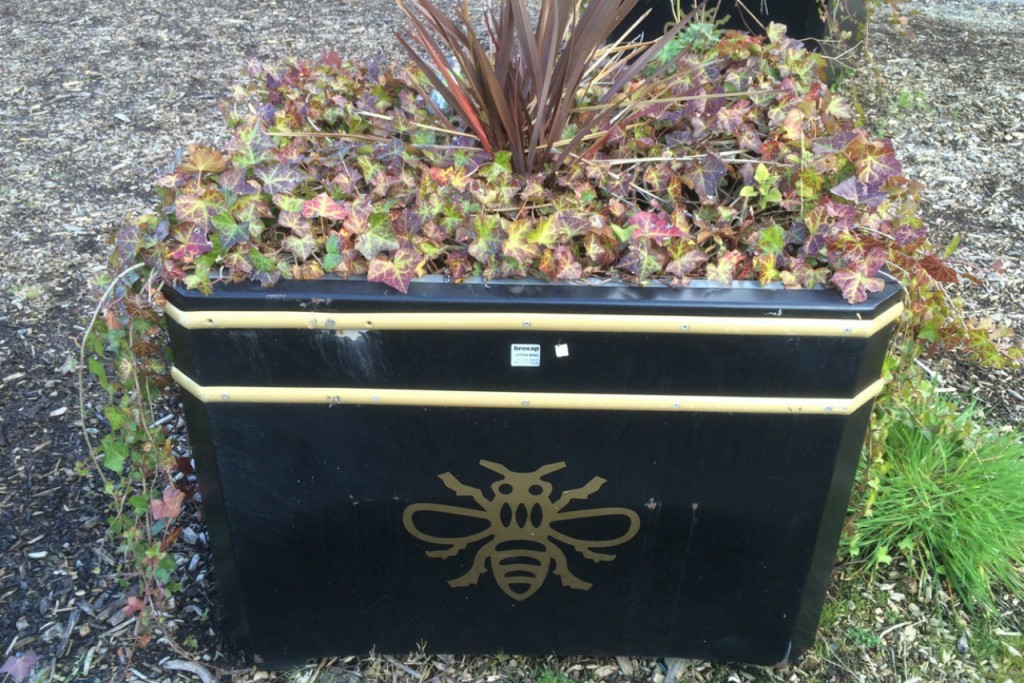
Credit: Copyright 2015 Clarissa Hyman
By Clarissa Hyman (Zester Daily)
Few of the commuters, shoppers and office staff in Manchester’s city center in northwest England know the roof of their historic cathedral is also home to around a quarter of a million workers.
They might feel some concern if they learn these other drones are, in fact, bees. Or they might marvel at the thought of “rus in urbe,” the rural pursuit of beekeeping in the crucible of the world’s great 19th-century Industrial Revolution. They might marvel as well as at the heavenly quality of the honey produced in these sacred surroundings.
Up on the roof
The project to keep bees on the leaden roof of the cathedral, which has medieval origins, was originally encouraged by its dean as part of the “Dig the City” urban garden initiative in 2012. The project has grown each year, as have the honey yields.

Credit: Copyright 2015 Clarissa Hyman
For the greater good
Honorary Canon Adrian Rhodes tends his hives with all the devotion of a biblical shepherd for his flock. In the fascinating structure of bee society, he sees some parallel with medieval monastery life where one person reigned supreme, all had their allotted jobs, the community came first and individuals would sacrifice their lives for the greater good — just as a bee dies once it has stung.
It is a recent calling for the former hospital chaplain and psychotherapist of international standing known as the “Canon Apiarist,” who also keeps bees and makes honey at his suburban Manchester home.
A modern twist
Urban and suburban beekeeping is a relatively modern activity but one that increasingly makes sense as monoculture, chemicals and loss of habitat, such as wild meadows and hedgerows, dominate the agricultural landscape.
And, according to Rhodes, city bees provide the best honey.

Sweet treat for bees
Honeybees can fly up to a kilometer from their hives, and inner-city Manchester provides fine foraging. Many canals and railway lines, remainders of extensive Victorian industrialization, have untouched verges. Allotments also provide some of the best hunting grounds, and in return the bees pollinate the produce.
Add to that roof gardens, window boxes, parks and tree-filled squares, and Rhodes’ “ladies” have no need to roam far from home. One lime tree in flower, he explains, can have as much potential as an acre of field. And, although the invasion of the Himalayan balsam plant is cursed by many, it is a sweet boon to the honeybees.
‘You can’t run away’
The cathedral runs a program to help the long-term unemployed, and Rhodes mentors a trainee beekeeper to help him or her learn important life skills.
“You’ve got to turn up on time, take orders and show patience, courage and calmness. The bees must always come first,” he says. “When you get thousands of them buzzing around you, it can be a bit scary but you can’t run away or abandon them. You have to complete the task and learn how to think under pressure.”
Calm above the city
It’s not just the trainees who take away these life lessons. As Rhodes says, “Beekeeping teaches me to take time out from a busy life, and gives me a calm moment out of time.”
It may also be the effect of the aromatic church incense smoke he uses to distract the bees when he needs to lift the frames from the hives.
Rooftop challenges
The honey may be blessed, but collecting it can also be a blessed nuisance. The hives have to be secured against wind (highly problematic on a building whose ancient structure is under government protection), and the heat off the lead roof can also cause the beekeeper problems in summer.
A lack of water supply on top of the the building makes it even more complicated. Access by narrow Harry Potter-style stone spiral steps is also a problem, especially when it comes to removing the honey-dripping frames for extraction. A good supply of plastic bags and a chain of volunteers is the answer.
Heavenly Honey
The extraction is done in the cathedral, where they also jar and label the “Heavenly Honey.” It is neither pasteurized nor heat-treated, simply filtered, and the jars are sold to the cathedral community at a modest price, although there are plans to sell online.
The city’s symbol
Coincidentally, the civic symbol of Manchester is a bee: It reflects a city that is industrious, hardworking, innovative and community-minded, part of a region that also saw the birth of the great cooperative movement in 1844 to provide an affordable alternative to poor-quality and high-priced food and provisions.
The canon apiarist’s bees are part of a proud tradition.
Copyright 2016 Clarissa Hyman via Zester Daily and Reuters Media Express





